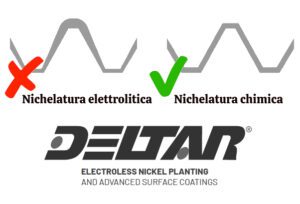The
nickel plating
chemistry
and the
nickel plating
electroless
are two different processes of surface coating with nickel. (see in-depth Wiki and on galvanic corrosion)
They differ in the process that allows the nickel layer to be deposited on the object.
The common element of chemical and electrolytic nickel plating is the raw material: nickel. However, the processing, results and subsequent areas of application are different.

Table of Contents
ToggleChemical nickel plating
Electroless nickel plating, also known as electroless nickel deposition, is a surface coating process that occurs solely by chemical means, without the use of electricity. The machining process by chemical means allows the nickel coating to be of uniform thickness throughout the part. This chemical nickel plating process provides corrosion and wearresistance. In addition, it is anti-friction, that is, it has the property of reducing friction between two surfaces in contact with each other. Chemical nickel plating is applicable to objects of all major alloys: aluminum, iron, copper, and titanium, and is suitable for many areas of application.
How does it work?
Chemical nickel plating is done by a chemical reaction to deposit a desired, homogeneous layer of nickel on an object or part of an object. Processing can be divided into two basic stages: pretreatment or degreasing where it is essential to subject the part to be coated to three different degreases: chemical, anodic, and cathodic . These three absolutely different processes give the surface essential characteristics for obtaining a defect-free deposit, a quality essential for obtaining optimal and compliant deposition.
Of course, prior to the process, preparation actions can be carried out in accordance with the required specifications, which may include sandblasting, cleaning, protection and/or masking.
Throughout the process and at its conclusion, special checks are carried out to assess the quality of processing and finished product according to Astm, Iso etc. specifications.
The chemical nickel plating process is suitable for coating many objects, even those with complex shapes. Specifically, chemical nickel plating is applied in different contexts: mechanical, chemical, pharmaceutical, construction, oil and gas, aerospace, nuclear , automotive, military , logistics and transportation. In addition, chemical nickel plating is optimal in precision mechanics because it combines multiple advantages: precision, thickness uniformity, high hardness, and resistance to wear and corrosion.
Electroless nickel plating
Electroless nickel plating is a galvanic treatment that is performed to coat a metal object with nickel. Specifically, it is an electric current deposition process in which a layer of nickel is deposited on the surface of the object through an electrochemical process. The object is used as the anode in a solution of nickel salts and while a platinum or nickel electrode is used as the anode.
How does it work?
In electroless nickel plating, metal is immersed in specific baths, in which electric current allows atoms from nickel rods to be attracted to the surface of the object. This will result in a deposit with a glossy, thick shiny appearance.
The process of electroless nickel plating is mainly used in thedecorative field to give a silvery metallic appearance. It is usually combined with an underlying copper coating for the purpose of increasing adhesion and giving a shiny, glossy appearance. It has medium hardness and modest corrosion resistance.
Chemical nickel plating: what is it used for?
Chemical nickel plating is mainly used in technical fields and has many advantages:
- Corrosionprotection: nickel layer preserves against corrosion. From simple oxidation generated by weathering to oxidation induced by corrosive acids such as sulfur dioxide SO2 Kestrnich test.
- Wearresistance: nickel significantly increases wear resistance ,thereby increasing the service life and longevity of machinery and tools.
- Homogeneous deposition over the entire surface thus avoiding both the tip effects typical of electrolytic deposition
- Appearanceimprovement: chemical nickel plating improves the aesthetic appearance of an object , making it shinier and brighter.
- Increase the hardness up to values of 1000HV
- Reduces friction
Deltar’s chemical nickel plating: the process
Deltar is the world’s largest company in the chemical nickel plating market, specializing in high phosphorus electroless nickel, the codeposit of Chemical Nickel-Silicon Carbide (NiSiC) Delsic and Nickel-PTFE. Its strengths are: speed,excellent quality andhuge production capacity.
In fact, Deltar has facilities not only consisting of very large process tanks but also everything that facilities of that size need: from furnaces for subsequent heat treatment to lifting and handling equipment that support weights and sizes of the processed parts themselves .
Dedicated blasting and protection departments , areas for pre- and post-production inspection and storage as well as areas prepared for inspection by internal and external inspectors.
All this means that being a leader in the production of extra-size parts ensures that all required international standards are met, assuring the market of the highest quality products with a quality not otherwise obtainable. Working according to international standards requires that the whole company be developed according to the size and weight of the part to be processed, which cannot be reduced to the simple large tank.
So much so that Deltar guarantees machining for objects up to 58 tons, with dimensions that can reach over 5 meters in length and 2.6 meters in diameter
Each process involves treatment of excellence, with a strong focus on quality and safety. Every piece processed by Deltar is certified, from start to finish.
Deltar is an Industry 4.0, where the integration of newproduction technologies improves working conditions, increases productivity and the quality of plants.

